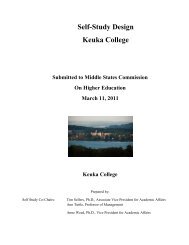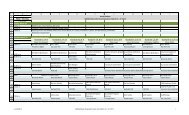final version of the self-study document - Keuka College's Middle ...
final version of the self-study document - Keuka College's Middle ...
final version of the self-study document - Keuka College's Middle ...
Create successful ePaper yourself
Turn your PDF publications into a flip-book with our unique Google optimized e-Paper software.
eports from <strong>the</strong> Center for Experiential Learning, annual ASK Office reports, <strong>the</strong> June<br />
2012 Taskforce on Academic Program Prioritization Report, <strong>the</strong> New Student Program<br />
Evaluation (NSPE), and annual program assessment reports. Results from <strong>the</strong>se<br />
assessments are available on <strong>the</strong> College Share drive. Performance indicators which are<br />
annually shared with <strong>the</strong> Board and <strong>the</strong> community at large include annual reports on<br />
enrollments across all programs, results <strong>of</strong> institutional fundraising efforts, as well as<br />
retention and graduation rates. Progress in achieving institutional goals is systematically<br />
assessed on a regular basis, with modification <strong>of</strong> initiatives and operational tactics as<br />
necessary. Evidence <strong>of</strong> reporting and discussion with relevant constituents can be found<br />
in <strong>the</strong> Board <strong>of</strong> Trustees Minutes, Faculty Minutes, <strong>the</strong> President’s Annual State <strong>of</strong> <strong>the</strong><br />
College address, and Academic Council Minutes.<br />
Analysis <strong>of</strong> <strong>the</strong> soon-to-be completed Strategic Plan 2009-2012 provides evidence that<br />
<strong>the</strong> College achieved many, but not all, <strong>of</strong> its goals. The nine initiatives <strong>of</strong> <strong>the</strong> Strategic<br />
Plan focus on institutional growth, expanded programming, increased revenues, and an<br />
enhanced learning experience for students. As noted in Chapter 2, <strong>the</strong> College has<br />
expanded its <strong>of</strong>ferings <strong>of</strong> degree programs across New York State and overseas,<br />
sufficiently increased revenues which were reinvested in employee salaries and services<br />
provided to students, and improved its financial stability. Significant institutional<br />
resources were dedicated to supporting and building capacity in <strong>Keuka</strong>’s non-traditional<br />
program areas, with limited ability remaining <strong>the</strong>n to allocate resources to fundraising or<br />
increasing <strong>the</strong> endowment. Consequently, fundraising has not improved substantially,<br />
with but moderate growth in <strong>the</strong> Annual Fund, Capital Giving, and Endowment Giving<br />
(Appendix 4.3 Fundraising Totals). Currently without a Vice President for Advancement,<br />
<strong>the</strong> College recognizes <strong>the</strong> need to fill this key position and to develop a strategy that will<br />
aggressively increase <strong>the</strong> endowment.<br />
Appendix 4.4 Strategic Plan Report Card 2009-2012 also indicates that many activities,<br />
ones that are essential to mission and institutional performance, will continue into <strong>the</strong><br />
next Strategic Plan, although <strong>the</strong> initiatives <strong>the</strong>mselves will be reconfigured. The several<br />
drafts-to-date carry forward several operational goals which focus on streng<strong>the</strong>ning<br />
academic programs, fundraising, lowering tuition dependency, and creating a better<br />
learning environment. Stronger accountability through enhanced tracking and analysis <strong>of</strong><br />
results is also a key <strong>the</strong>me <strong>of</strong> <strong>the</strong> current strategic planning work, echoing <strong>the</strong> 2009-2012<br />
goal to “streng<strong>the</strong>n <strong>the</strong> culture <strong>of</strong> <strong>self</strong>-assessment across <strong>the</strong> institution.”<br />
In response to this goal <strong>of</strong> streng<strong>the</strong>ning <strong>the</strong> culture <strong>of</strong> <strong>self</strong> assessment, <strong>the</strong> College has<br />
raised awareness and expanded expectations <strong>of</strong> assessment across all areas. Formative<br />
evaluation <strong>of</strong> assessments, including examining <strong>the</strong> quality, utility, and use <strong>of</strong><br />
assessments to inform decisions, is now ongoing and demonstrated in a number <strong>of</strong> ways.<br />
Appendix 4.5 Table 4.2: Approaches to Assessment Among Non-Academic & Discipline<br />
Units provides evidence that <strong>the</strong> College has improved its processes to assess institutional<br />
effectiveness. For example, <strong>the</strong> non-academic units provide evidence <strong>of</strong> using <strong>the</strong> Noel<br />
Levitz results more regularly to inform <strong>the</strong>ir <strong>self</strong>-evaluation. The use <strong>of</strong> <strong>the</strong> Noel-Levitz<br />
not only provides <strong>the</strong> non-academic units with useful information for continuous<br />
improvement, but allows administrators to utilize this data for decision-making purposes<br />
Page 3 <strong>of</strong> 31 Chapter 4: Inst. Effectiveness & Assessment




